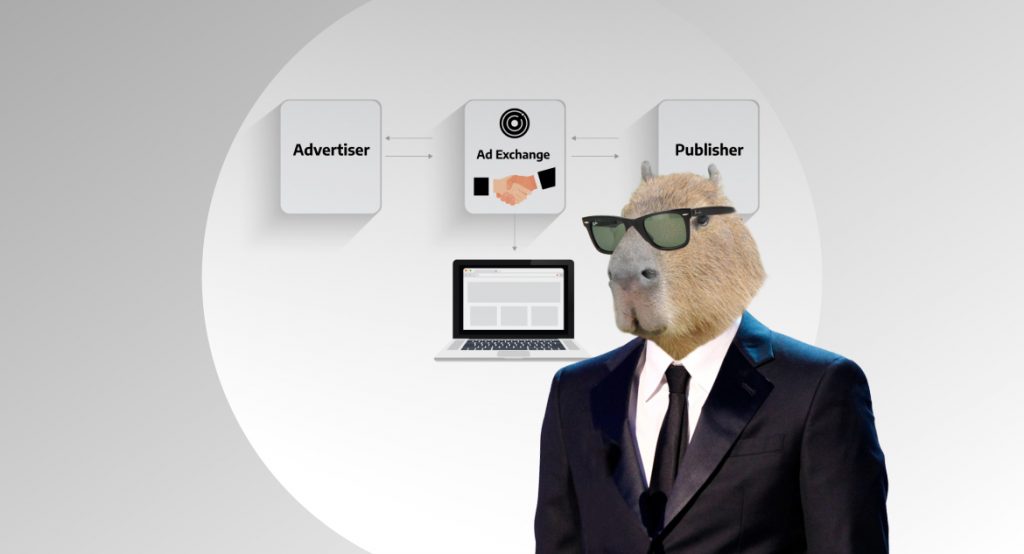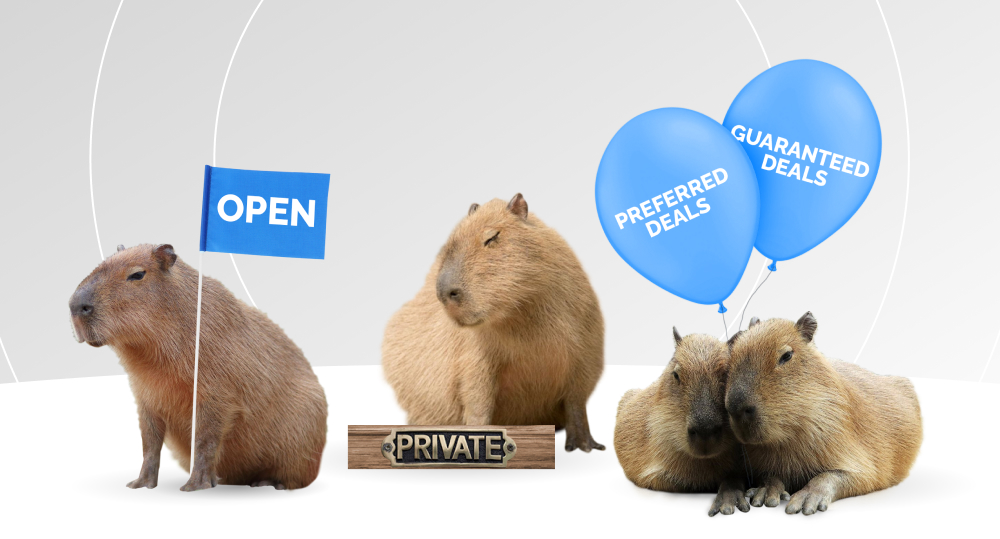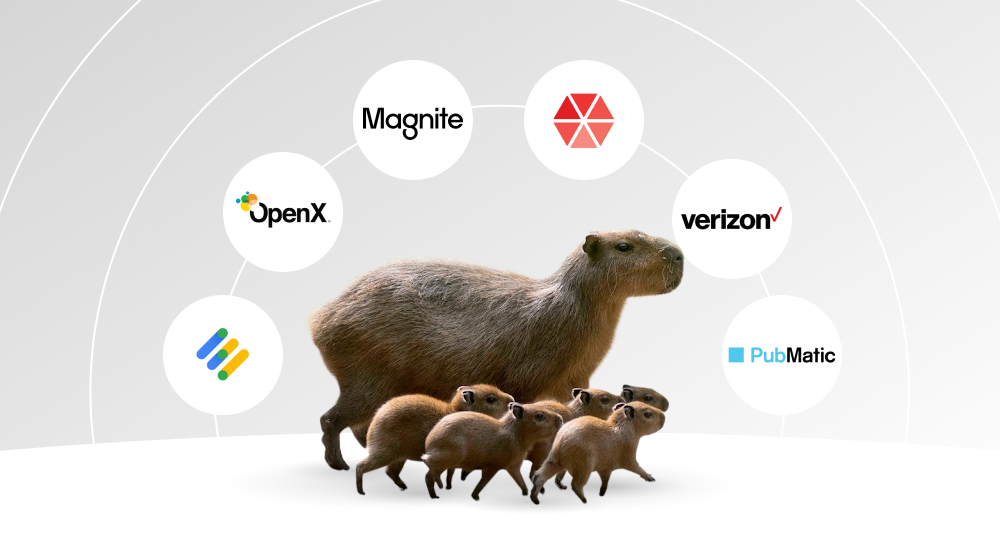How much do businesses spend on digital advertising? Let us take just one segment — programmatic display ads. According to eMarketer, digital ad spending worldwide reached $521 billion in 2021, and it was an all-time high. Pretty impressive rise, isn't it? One of the significant contributions to such a grand increase is the wide range of available ad space and forms of innovative advertising technologies. So, when you have an answer to the question "What is an ad exchange platform" you will be able to take the most that the market puts forward.
In our article, you will find the most up-to-date review of ad exchanges and trends. Should we wait any longer? How about starting right away?
WRITTEN BY:
Alexey Kovsh
Senior Solutions Architect
Contents
What Is an Ad Exchange?
First, let us briefly specify what an ad exchange is. Well, it is an advanced technology platform for publishers and advertisers where they can sell and buy various types of ad inventory: mobile, display, in-app, etc.
What is more, an ad exchange is a platform where multiple ad networks come together. Through real-time bidding technology (RTB) for buying and selling inventory, the ad prices are determined on an impression basis.
Indeed, an ad platform is a favorable source for publishers and advertisers. As for publishers, they can easily sell advertising inventory and get a bigger bang for their buck from a vast pool of advertiser demand on a consolidated platform. Buyers and advertisers reach a mass audience and can increase their ad campaigns' effectiveness through advanced targeting technology.
What Types of Ad Exchanges Are There?
How many types of platforms are there? With such a vast digital market, there must be loads of tailored options available.
Nonetheless, there are just two principally different cases in point — Open Ad Exchanges and Private Ad Exchanges. Additionally, there are also two special types of ad collaboration (Preferred Deals and Guaranteed Deals), which are also worth mentioning. Let us have a closer look at them.
Open Ad Exchanges
They are digital marketplaces open for all buyers where you can find extensive inventory from a broad list of publishers. So, you get the widest choice for maximum publicity of your ad campaigns.
However, open ad exchanges have a significant disadvantage, as the buyers do not get detailed info about the publishers. It can lead to digital ad fraud threats, bot activity, or malware.
Private Ad Exchanges
They are closed platforms with full control over prices, conditions, and the selection criteria for buyers who can make bids. Private marketplaces are run by individual publishers and advertisers, who has the power to adjust the whole process.
For example, they may permit to make deals only with chosen agencies or other regular buyers. They also may ban third-party members like ad networks from the reach of their pool of impressions.
On the other hand, it is a much more time-consuming process when you have to negotiate with buyers. No wonder, that the vast default inventory of an open ad exchange is a "premium" option for a private ad exchange.
Preferred Deals and Guaranteed Deals
Frankly speaking, it is hard to refer these types to ad exchanges as they do not involve auctioning. But they are also vital for understanding the modern advertising industry.
- Preferred or Direct Deals are used when there are special agreements between a publisher and an advertiser about the price for the ad inventory.
- Guaranteed Deals are very much similar to direct deals. But they implement programmatic automation into the process rather than rely on a manual option. Here, a publisher agrees to provide ad units for an advertiser at a predetermined price.
Both types of deals are usually specific to the premium inventory segment. For instance, there can be an exclusive ad space for a single brand on a website or a mobile app.
Preferred or guaranteed deals create an unfailing revenue for publishers, and advertisers get a guaranteed volume of ad impressions without the necessity to bid.
How Do Ad Exchanges Work?
Now it is time to dive into the tech side of the matter. To understand the core mechanism of an ad exchange, we should turn to those six steps that are inherent to every platform.
- A publisher places the inventory on an ad exchange through a supply-side platform (SSP). It is important to provide the fullest list of details on the inventory: URL, page location, topics, audience, etc.
- Ad Requests (or Bid Requests) automatically appear on the auction when a user enters the publisher's app or website.
- The ad exchange platform sends a request for the bid to ad networks and demand-side platforms (DSPs). The bid request and information about it are carefully inspected by every DSP. They examine user ID, geolocation, demographics, frequency capping, and other targeting options.
- Then, the ad exchange studies the advertisers that bid on the impression. The main task of this stage is to eliminate the advertisers that do not meet the publisher's requirements.
- Let’s take the following example for illustrative purposes. There is an ad slot on a French website. And there is a restriction by the publisher who wants to have only French-language ads on the resource. That is why the ad exchange has to choose ads only in French for the auction.
- When the ad exchange has gathered all the necessary data, it analyzes available bids, and the impressions are sold to the highest bidder.
- During the final stage, the winning ad is placed on the publisher's resource, and the user sees it. As the RTB process takes less than a few milliseconds during the page load, the user is unaware of the tech behind programmatic ad buying. What is more, it does not interrupt or influence the page loading speed or user experience.
What Are the Good Examples of Ad Exchanges in 2022?
There are multiple ad exchanges for publishers and advertisers on the market today. We have handpicked the most significant ones for you.
Google Ad Exchange
You may not be surprised that the largest ad exchange in the world is under the Google brand. Google AdX provides one of the highest CPM across the advertising industry. So, publishers can sell their inventory at top prices. In parallel, advertisers get access to billions of users worldwide and premium audience targeting options.
Though, the entry requirements of Google Ad Exchange are among the highest as well. But when you fulfil all the rules, Google AdX can become your cash cow.
OpenX
The ad exchange connects over 230 thousand publishers and advertisers. OpenX is a 100% cloud-based independent exchange that supports omnichannel ad formats and provides transparency and high inventory quality.
One more distinctive feature of the ad exchange is its special concern about ad fraud protection. The company also offers upgraded targeting options, adjustable impression predictions, and outstanding integration technology for combining video ad networks and SSPs to RTB.
Magnite
This programmatic ad buying and selling platform has derived from the successful Rubicon Project. Today, Magnite can boast such loud names like eBay or The Wall Street Journal.
The ad exchange offers first-rate ad inventory, exclusive brand-safety options, and progressive header bidding options. Magnite is also a convenient tool for premium publishers to get access to private ad exchanges with the highest CPM and the best marketable ad inventory.
Xandr
Xandr started its journey as AppNexus. Now it serves more than 11.5 billion ad impressions every day. The platform is cloud-based, supports various types of ads, and offers top-notch header bidding techniques and selective inventory providing.
Xandr also users value advanced analytics and in-depth insights that ensure transparency of all transactions. In December 2021, the platform was acquired by Microsoft.
Verizon Media
The brand is a famous technology and media mogul that offers an outstanding ad exchange under its umbrella. Verizon Media has an extensive list of partners, publishers, and advertisers. No wonder, that it serves about 2 billion ad impressions daily.
The clients of the platform get a progressive set of inventory management tools for prebidding, header bidding, direct deals, etc. With Verizon Media, you can use diverse monetization solutions across various ad formats and multiple devices.
PubMatic
This ad exchange is a subdivision of a prominent advertising industry giant. It serves more than 171 billion ad impressions each day. So, in terms of the reach, PubMatic is one of the most impressive ad exchanges in the world.
On the platform, users get DMP integrations, robust ad fraud protection, advanced analytics, inventory quality control, and many next-gen advertising features, etc.
In a Nutshell
In another eMarketer research, they found out that in 2021, US advertisers spent $106 billion on programmatic digital display ad spending, which is 41.2% more compared to the previous year. And this flying high does not tend to reverse the trend of implementing new approaches in the ad industry. With an ad exchange, publishers can comfortably sell their ad inventory, and advertisers can reach the best audience for their products and services.
Thus, programmatic advertising technology does have a bright future ahead. And ad exchanges are making it closer and more accessible, especially for smaller brands.
Want to know more about our Adtech Software Development expertise? Feel free to contact our specialists and get the most valuable support.

Contacts
Feel free to get in touch with us! Use this contact form for an ASAP response.
Call us at +44 151 528 8015
E-mail us at request@qulix.com










